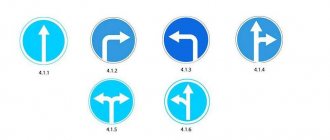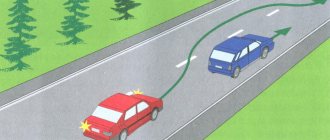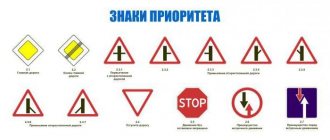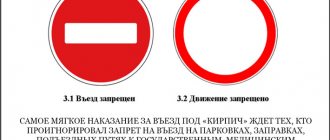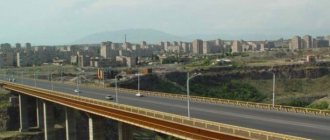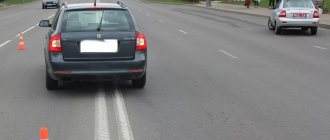What does the sign look like, where is it usually installed and what is its coverage area?
To begin with, it should be said that changes in overtaking rules have significantly changed the situation on Russian roads. A certain category of drivers who have been driving for many years (and they are the majority) have firmly grasped the principle that overtaking on the right is prohibited. And therefore, the car in their rearview mirror, which is approaching them from the right, causes an instinctive desire to give way to it and turn the steering wheel in the same direction. Often a collision in such a situation is simply inevitable. That is why it is necessary to strictly observe traffic rules, monitor the latest changes in them and follow the instructions of signs and road markings.
This is what a stationary sign prohibiting overtaking looks like
The “No Overtaking” sign is one of the prohibitory signs. He has a personal number in Russian traffic regulations - 3.20. When installed, this sign must strictly prohibit overtaking of almost all vehicles. The only exceptions will be mopeds and two-wheeled motorcycles without sidecars, horse-drawn vehicles, bicycles and low-speed vehicles. The “Overtaking is prohibited” sign is installed on those sections of the road that can become dangerous in the event of overtaking: on turns, slopes, areas with poor road surface, narrowing areas, etc.
The section of the road covered by the sign starts from the place where it is installed and up to the first intersection in the direction of travel. In populated areas, the sign is valid (in the absence of intersections) until the end of the populated area. The effect of the sign cannot be interrupted by exits from adjacent territories and in those places where the main road intersects with country roads, forests and other roads that can be considered adjacent and secondary. These can be considered those roads that do not have a hard surface and a sign indicating an intersection.
Drivers should remember that exits from yards are not intersections and, accordingly, do not cancel the effect of the “No Overtaking” sign.
The coverage area is also limited by an additional indication of the distance of its relevance, which is given directly under the installed sign. The zone is also limited by signs indicating the cancellation of the action of this sign (“End of the prohibited overtaking zone” - No. 3.21) and the sign “End of the zone of all restrictions” (No. 3.31 in the traffic rules).
By the way, the name of this sign smacks of pretentiousness: it cancels only nine prohibitory signs and in no way can cancel all the real restrictions that a domestic driver may face, especially when it comes to the Russian outback. There are certain restrictions for which signs are not required. The main thing in their definition will be the instinct of self-preservation.
This is what the “End of all restrictions zone” sign looks like
Special mention should be made of ignoring the “Overtaking prohibited” sign (including) in the southern regions of Russia. Statistics show that it is the Southern Federal District that is distinguished by its systemic disregard for road signs and markings. On some roads (for example, in Bashkiria) there are often no road markings, which have not been applied for decades. In big cities, drivers still try to comply with the requirements of road signs, but rather out of a sense of self-preservation due to the heavy traffic on the roads.
Where is it installed and according to what rules?
Drivers even without special signs should know that overtaking into the oncoming lane is prohibited:
- at a pedestrian crossing;
- in tunnels;
- near a railway crossing;
- at the crossroads.
As a rule, installation of a sign in the listed areas is not required. You can find him:
- on dangerous sections of the roadway where accidents often occur;
- before going uphill;
- in places where the road narrows;
- before sharp turns;
- in places where the road is bad.
Signs are installed 15 meters before the dangerous area so that the driver knows in advance about the upcoming obstacle.
Often sign 3.20 is installed with other signs and markings. For example:
The picture shows that there are two signs: “Overtaking is prohibited” and “Slippery road”. In this situation, it is dangerous to get ahead of the vehicle due to skidding.
And one more option:
In this example, you can see that drivers should reduce their speed to 50 km/h and not overtake the vehicle in front due to the uneven road.
This is what a temporary sign establishing a ban on overtaking looks like:
It is worth considering that traffic police inspectors often catch violators after a sign prohibiting overtaking. This sign is violated as often as the speed limit.
Sign on a yellow background
If the driver sees a “No Overtaking” road sign on a yellow background, then such a sign is temporary.
If the “No Overtaking” sign is on a yellow background, then it is installed temporarily and has priority over permanent signs
It is installed to ensure safe traffic on those sections of the road that are under construction or repair. The signs that drivers see on a yellow background can be prohibitive or warning.
If a “white” sign is installed next to the “yellow sign”, and its action contradicts the “yellow” one, then the sign on the yellow background has priority. This statement is also relevant for orange markings, which serve to separate the traffic flow on sections of the road under construction or repair. The traffic rules indicate the priority of such markings over white markings.
No overtaking sign
Knowing the rules of the road can prevent many problems. If the driver does not pay attention to the signs along the road, then he risks not only running into a fine, but also increasing the risk of an accident. Recently, punishment for offenses has become increasingly strict, so compliance with road signs has become even more important. Every driver should re-read all the information about road signs from time to time. One of the most common are signs restricting traffic in the oncoming direction. What does a “No Overtaking” sign look like? It is an image of two red and black cars driving next to each other. The “Overtaking is prohibited” sign in the traffic rules is indicated by number 3.20, and at the end of the prohibition zone you can see sign 3.21. As a rule, overtaking bans are placed on narrow or dangerous sections of the road where overtaking can lead to an accident.
Possible violations that drivers may commit
First, you need to define the very concept of overtaking. Until recently, in traffic rules, this meant that a moving vehicle is ahead of one or more moving vehicles and at the same time leaves its lane. In the current version of the Rules, overtaking is interpreted somewhat differently. It means that the vehicle is ahead of one or more cars in its movement. In this case, overtaking occurs only in the case when the vehicle enters the lane of oncoming traffic, and then returns to the lane it previously occupied. The new edition of the traffic rules has significantly narrowed the concept of overtaking. Drivers who received a driver's license a long time ago and last opened a traffic record book many, many years ago should pay special attention to this innovation.
Violation of the requirements of the “Overtaking is prohibited” sign is overtaking one or more vehicles within its coverage. This may be caused, first of all, by the driver ignoring this sign. It goes without saying that an inattentive driver who did not see this sign while talking with passengers is also a violator.
Video about what overtaking is in practice
Controversial situations
Sometimes particularly “advanced” drivers consider the installation of a “No Overtaking” sign on a certain section of the road to be unreasonable and, accordingly, ignore it. It is clear that they will not be able to prove to the traffic police inspector their innocence or the absurdity of the installation in a certain place. In practice, a large number of controversial situations arise. Let's take a closer look at the most typical ones.
Situation one
The driver of a moving car began the overtaking maneuver even before the sign prohibiting overtaking began to operate, and ended it directly within the coverage area. The reason for this could be, for example, that the vehicle moving in front obscured the sign, and the driver driving behind simply did not see it. In such a case, you should carefully look at the markings on the road. Before a section of the road where overtaking is prohibited, the dashes that make up the broken line lengthen and gradually turn into a solid line. Even if the driver did not see the sign, his actions are unlikely to be justified, and the traffic police have every reason to punish him.
Second
The driver of a moving car sees a vehicle moving at low speed, for example, less than 30 km per hour. Accordingly, in order to continue driving, he will need to enter the oncoming lane within the limits of the overtaking ban. The question is whether the vehicle that the driver overtook is slow-moving. You should know that low-speed vehicles must be marked with special icons in the form of red triangles with a yellow border. If such a symbol is not observed on the vehicle being overtaken, then it cannot be considered slow-moving and overtaking in this case will become a clear violation of traffic rules.
This is what the slow-moving vehicle sign looks like and is located:
Third
Sometimes there is simply no way to avoid violating the validity of a sign. This can happen, for example, when you have to go around a large hole (a common occurrence), a stationary car, or a place where an accident recently occurred. In such a case, you should try to go around such an obstacle on the right. If this is not possible, then you will have to go around, entering the oncoming lane. In this case, traffic police officers can “incriminate” a violation with subsequent significant damage to the personal or family budget. But you should know that in the vast majority of cases in such situations, the rules allow such a maneuver. But oddly enough, the inspector can interpret this in his own way. Therefore, the driver should understand that he will be able to prove his innocence in court and, accordingly, disagree with the inspector’s conclusions in the compiled protocol.
Fourth
Sometimes a driving driver may be surprised to notice that the markings on the road are in clear contradiction with the requirements of the installed signs. For example, a section of the road where, behind the “No Overtaking” sign, there are intermittent markings that clearly allow such a maneuver, can throw a law-abiding driver into a stupor. What to do ?
Logically, the presence of a broken line indicates that the limited visibility zone has ended and, accordingly, the prohibition of overtaking is no longer relevant. But the fact is that it was not in vain that the “vigilant” inspector waited for many hours for such a situation to arise. He boldly stops the “violator” and draws up a report. So, the protocol should not be signed in this case either. You should once again open the booklet, which details the traffic rules, and make sure that the road markings have priority. The only exceptions will be temporary signs that require restrictions on certain actions of drivers (for example, the same sign on a yellow background). At the same time, the inspectors themselves must take measures to correct this ambiguous situation on the road.
A driver who knows the traffic rules well should behave confidently and remind the traffic police of their immediate responsibilities in this case. Most likely, they themselves know this, so the conversation may end with a vague: “Don’t disturb again” and wishes for a safe journey.
Video about controversial situations when overtaking
Description of the sign
The “No Overtaking” sign looks like a circle with a white background and a red border. In the center there is a schematic image of a red and black car.
There are different forms of drawings of cars on the sign, but its essence does not change.
This sign prohibits overtaking other vehicles, with the exception of slow-moving vehicles, as well as various horse-drawn carriages, two-wheeled mopeds, scooters, motorcycles without a side trailer and, of course, cyclists (both single and groups).
It can be equipped with additional signs establishing the zone and duration of the ban.
The sign with the coverage area for the “No Overtaking” sign is paramount - alternative reasons for its termination are relevant only in its absence
One of the variants of the sign “Overtaking by a truck is prohibited” differs from the main one by the image of a truck, painted in red. It establishes a ban on overtaking for freight vehicles.
According to this sign, a truck cannot overtake either cars or trucks, but this prohibition does not apply to cars.
The “No overtaking” sign takes precedence over the markings if they contradict each other.
Drivers, be lenient (or you can still overtake someone)
Slow-moving vehicles are discussed above. These, for example, could be bulldozers, tractors, combines, and so on. If they have the appropriate badges on the back, then you can overtake them painlessly. Of course, a peasant's horse-drawn cart (drawn transport) is unlikely to be equipped with the appropriate sign. But you can also overtake it. As well as cyclists, motorcyclists (two-wheeled motorcycles and without sidecars), as well as mopedists. When overtaking them, experienced drivers sometimes break into a cold sweat, because they believe (and sometimes justifiably) that there is no worse person on the highway than a cyclist. You can expect anything from him. It can be swayed by a gust of wind, the bike can jump on a bump and suddenly change its trajectory, in the end, the cyclist can be completely drunk.
You should be especially careful when overtaking cyclists
The actions of mopedists, bikers and “drivers” of horse-drawn vehicles are not much more predictable. That is why, when overtaking such road users, you should be especially careful, slow down and try not to get too close to them, leaving yourself the opportunity to maneuver or brake in case of a critical situation.
The “Slow-moving vehicle” sign is indicated in the form of an equilateral triangle with a red fluorescent coating and a yellow or red reflective border (triangle side length from 350 to 365 mm, border width from 45 to 48 mm according to GOST) - behind motor vehicles, for which the manufacturer has set a maximum speed of no more than 30 km/h.
Paragraph 10 of clause 8 of Chapter 26 of traffic rules
There is no prohibition sign: when you still can’t overtake
It is also important to remind some drivers who have completely forgotten the traffic rules (or even never held a book with a similar name in their hands) that the “No overtaking” sign is not the only case of prohibition of such a maneuver on the road.
Overtaking at a pedestrian crossing is strictly prohibited, no matter whether people are walking along it or not. You also cannot overtake in tunnels, overpasses and bridges. It will be a violation to overtake at an intersection, regardless of whether it is regulated or not, as well as within a hundred-meter zone from a railway crossing. Overtaking on ascents or descents, where visibility for overtaking is insufficient, is also prohibited.
It’s absolutely forbidden to cheat in tunnels
When overtaking, you should very carefully monitor passing and oncoming traffic, maintain a safe distance and not interfere with other drivers.
The driver of the overtaken vehicle is prohibited from increasing the speed, as this may lead to an obstacle to overtaking and create an emergency situation on the road.
What are the consequences of ignoring the “No Overtaking” sign: fines in 2021
Violating the rules of overtaking very often leads to tragic consequences. Therefore, first of all, it threatens the lives of the driver, his passengers, the “crew” of the oncoming car and sometimes completely innocent road users who find themselves in the wrong place at the wrong time. It is precisely in view of the above that penalties for violators are quite severe. Over the past years, we can observe a significant increase in the size of fines. What ten years ago could be violated relatively painlessly for the wallet, today is fraught with serious financial losses.
As before, penalties for violating the rules of overtaking are determined by Article 12.15 of the Administrative Code.
In particular, paragraph four of Art. 12.15 of the Code of Administrative Offenses states the following:
Driving, in violation of the Traffic Rules, onto a lane intended for oncoming traffic or onto tram tracks in the opposite direction, except for the cases provided for in Part 3 of this article, shall entail the imposition of an administrative fine in the amount of 5,000 rubles or deprivation of the right to drive vehicles for a period of four to six months.
clause 4 art. 12.15 Code of Administrative Offenses
So, the minimum administrative punishment faces the violator in the form of a fine in the amount of 1000 rubles and the maximum - deprivation of a driver’s license for a period of four to six months. Interim fines will be 1,500 and 5,000 rubles. The first - for driving into oncoming traffic or tram rails when going around an obstacle (if it was possible to go around it on the right) and the second - for ignoring the requirements of a sign prohibiting overtaking and driving into oncoming traffic.
Particularly persistent violators of overtaking rules may lose their driver's license for a year if they repeatedly violate overtaking rules within a year. It is important to remember that the return of a driver's license becomes possible only after retaking the theory of traffic rules and therefore can result in a very long-term project, since by the time the license was revoked, everything that was taught in a driving school had already been completely forgotten.
The minimum you can hope for is a fine of 500 rubles, which will be issued for violating the requirements of road markings and prohibition signs. Although, to tell the truth, such cases are the exception rather than the rule. Usually they try to punish the driver as much as possible. Therefore, the only advantage in this situation will be the driver’s feeling of deep satisfaction from the fact that he has replenished the budget of his native country by a considerable amount.
If a violation of overtaking rules was recorded using technical means (photo or video recorders) that automatically register the violation without the participation of a traffic police inspector, then the driver can be fined a maximum of five thousand rubles, even if the violation itself leads to deprivation of rights.
Temporary sign instructions
In accordance with Section 8 of Appendix 1 to the Traffic Regulations, temporary signs on a yellow background may be installed in areas where road or repair work is being carried out. They are necessary for short-term changes in traffic regulation in a particular area.
The same paragraph notes that if a contradiction arises between permanent and temporary signs, the driver should be guided by the instructions of the temporary ones.
Temporary "No Overtaking" sign:
How to try to justify yourself and is it possible to avoid deprivation of rights
The question of how to avoid administrative liability arises for the driver at the very first moment after being stopped by a traffic police inspector. But you shouldn’t immediately sprinkle ashes on your head and repent of all your sins.
It is necessary to immediately understand that between an administrative fine of 5,000 rubles. and deprivation of a driver’s license, the word “or” is in the law. The decision on the punishment must be made by the head of the relevant traffic police unit based on the duration of the offender’s stay in the oncoming lane, the trajectory of his movement and many other factors. Circumstances can both mitigate and aggravate the liability of the offender. Therefore, all the circumstances of the offense should initially be taken into account. If, for example, the violating driver moved along the oncoming lane for a kilometer for no reason, creating several emergency situations, then he should hardly hope for a minimum fine.
The final decision on punishment is made by the court. Therefore, it is worth being well prepared for the process. If possible, it is advisable to entrust the protection of your interests to a specialized lawyer who has extensive positive experience in resolving cases related to violations of traffic rules. It is necessary to understand that the court (when a violation is detected on the road directly by traffic police officers) is not always limited to a fine of five thousand. Deprivation of rights leads to much bigger problems, so you should still play it safe and seek help from a car lawyer.
The final decision on punishment for traffic violations is made by the court.
You can independently challenge the decision of the traffic police inspector by proving that there was no real opportunity to go around the obstacle on the right. This did not allow us to determine the condition of the road surface on a given section of the road, the size of the car or the possibility of creating a dangerous situation for other road users, pedestrians, buildings, road structures, etc. Of course, the judge will not go to the place where the violation was committed, therefore in this case, a DVR recording will be of great help, which should display all the mentioned nuances.
The second way to challenge the decision on punishment will be to prove that the sign does not comply with the requirements of the law and was installed in violation of GOST (GOST R 52289–2004). Those signs that were installed without complying with the relevant requirements are in conflict with the rules of the road. Experience suggests that it is possible, but difficult, to prove that a sign does not comply with technical requirements. Therefore, you will have to fight in court.
The road service may apologize to the driver, but the court will not take into account the technical discrepancy. As a rule, courts are so overwhelmed with current work that traffic violators are like an annoying insect that interferes with work on more priority tasks. Therefore, consideration of the relevant cases often occurs quickly, while the judge does not delve into the essence of the case at all. Often, a meticulous offender can prove his innocence only in an appellate court.
By the way, as practice shows, it is the court of appeal that often makes fairer decisions on traffic violations than the court of first instance. But it should be taken into account that filing an appeal is not an easy task, especially for people who have never or almost never faced such tasks. Therefore, the participation of a lawyer will be very desirable. And, accordingly, it can significantly increase the cost of the procedure for restoring justice. That is why most drivers who have been awarded a fine resign themselves to such a court decision. Few people reach the Court of Appeal and, as a rule, those who have been sentenced to lose their driver's license. This factor sometimes becomes decisive in the relatively careless and superficial handling of cases of traffic violations.
By the way, sometimes you can even turn into a victim. This can happen, for example, in the case when a traffic police inspector drew up a protocol regarding a discrepancy between the requirements of a sign and road markings, although he should have immediately reported to higher management about the identified problem, and not looked for an opportunity to fine an unlucky driver who did not know the traffic rules thoroughly. If the driver manages to prove that he is right, the inspector will be punished, including dismissal from work. In such a case, information from the DVR will again be extremely important.
Video about some cases of installing a “No Overtaking” sign: practice of communicating with traffic police inspectors
In what situations is overtaking a violation of the rules?
You can pass other road users only where the maneuver will not create problems. An important condition is that it must be carried out on a section of the route where there is no prohibition on this. Overtaking is dangerous and therefore unacceptable in several situations.
Under the "No Overtaking" sign
An absolute prohibition on performing a maneuver exists where the corresponding symbol is installed. It is a white circle with a red border, inside which there are black and red cars, and is numbered 3.20. There is also symbol 3.22, which instructs trucks to avoid maneuvering.
For violating the “No Overtaking” sign, the fine will be 5,000 rubles. in both cases. The punishment is regulated by part 4 of article 12.15 of the Code of Administrative Offences. The amount is not small, since ignoring the requirements prescribed by road signs is one of the most serious offenses.
Symbol 3.20 is usually installed in areas where overtaking can actually lead to an accident. For example, on a narrow section of road where a collision with an oncoming car is most likely. Or in an area with heavy traffic. The sign is installed if the terrain is such that it is difficult to notice an oncoming car. It can also be found at the entrance to a populated area.
Given the seriousness of the likely consequences, the punishment for violating the “No Overtaking” sign may be more severe. Instead of a fine, the driver’s license is taken away for 4-6 months, which is also provided by law as an alternative to forced cash payment. And if the same offense is committed again, that is, within 12 months after the resolution is issued, the punishment is increased in accordance with the requirement of Part 5 of Article 12.15.
The inspection officer will draw up a protocol, and the court will select the driver's license for 1 year. If the violation is recorded on camera, the violator will get off with a fine of 5,000 rubles.
If a motorist does not want to be punished, he should wait:
- the appearance of signs 3.21 and 3.23 on the way, indicating the end of the territory covered by 3.20 and 3.22;
- or symbol 3.31, which is installed upon completion of the territory of all restrictions;
- until he passes a dangerous section of the road, the value of which is indicated on symbol 8.2.1 (it is placed next to “Overtaking is prohibited”).
Only after this can he bypass the vehicle moving ahead.
We recommend reading about accidents when overtaking. From the article you will learn about the options for road accidents when overtaking (when turning left, at an intersection, overtaking on the right), judicial practice in road accidents. And here is more information about accidents during lane changes.
Under a temporary sign, in the absence of markings
A symbol prohibiting overtaking may be displayed for a certain period of time. For example, while road repairs are underway. The road sign looks the same as 3.20, but the background of the circle is yellow instead of white. Its presence means that in the action area you can only drive in your own lane, without passing other vehicles. The requirement exists despite the presence in this zone, for example, of symbol 3.31 (“End of all restrictions”). After all, there is a rule:
In cases where the meanings of temporary road signs and permanent road signs contradict each other, drivers must be guided by the temporary signs.
The condition is dictated by clause 8.24 of the traffic rules. If you ignore the temporary “Overtaking prohibited” sign, the violation will be under the same article 12.15. That is, the punishment will be 5,000 rubles. fine or deprivation of driving license for 4-6 months.
A temporary overtaking symbol may conflict with the markings on the road. This happens very often. For example, a road is being repaired, which will not last forever. But the space for cars to pass is narrowing, so a temporary restrictive symbol is being installed. And no one is changing the intermittent markings to continuous ones. Or it’s not there at all, which in other conditions seems to indicate the possibility of overtaking. But here it is worth remembering the traffic rules requirements:
Road markings are of secondary importance in relation to road signs. If the markings are difficult to distinguish or their meaning contradicts the meaning of the signs, the latter have priority.
In cases where the meanings of road signs, including temporary ones, and horizontal markings contradict each other or the markings are not sufficiently distinguishable, drivers must be guided by the road signs. In cases where temporary marking lines and permanent marking lines contradict each other, drivers must be guided by the temporary marking lines.
Therefore, violating the “Overtaking prohibited” sign in the absence of markings will still result in a fine of 5,000 rubles for the driver. or loss of temporary residence permit for 4-6 months. You can try to justify yourself by saying that the symbol is poorly visible, but the inspector and the court are unlikely to accept this.
Along the continuous
In an area where overtaking is prohibited, there may not be a prohibition sign. A marking that is a solid line is sufficient. There is a clause in the traffic rules that prescribes a ban on crossing markings 1.1, 1.2 and 1.3.
But the violation of overtaking through a continuous road is punishable under various articles. If the driver entered the oncoming lane to maneuver, but saw an obstacle and turned into his lane across the dividing line, he faces punishment under Part 3 of Article 12.15. This is a fine of 1000-1500 rubles. When crossing a solid road at the final stage of the maneuver, Section 4 of the same law is applied to it. The fine will be 5000 rubles. And if the court decides to take away the rights, the period of deprivation will be 4-6 months.
At a pedestrian crossing
Traffic rules prohibit overtaking at zebra crossings. This is quite justified, since the area is specially designated for pedestrians. Each of them feels safe there, so it is difficult to predict the actions of a person “without wheels” in this zone. He may run out of the sidewalk suddenly, and the vehicle that has accelerated to overtake will not have time to brake. Or the driver will not see the pedestrian at all because of the car that is trying to pass.
Therefore, violation of overtaking at a pedestrian crossing is punishable by a fine in accordance with Section 4 of Article 12.15 of the Administrative Code. And you can get for a misdemeanor and deprivation of rights for a period of up to six months.
Punishment awaits the driver regardless of whether there were people at the pedestrian crossing at the time he made the maneuver or not. All cars and other types of transport must pass through this section without overtaking each other.
At the crossroads
The intersection of roads in different directions is also a high-risk area. After all, cars are driving from different directions, at high speed, as they strive to leave this area faster. Therefore, it is prohibited to overtake here if:
- we are talking about an unregulated intersection, and the road is secondary;
- There are traffic lights in this area.
In the first case, the driver needs to focus on signs that make it clear which road is the main and secondary one. You cannot overtake anyone who is moving along a path where there is a sign in the form of a white triangle with a red border around the edge. On a road marked with a yellow diamond with a white border, you can overtake. But this is provided that no one is driving towards you, and other rules for safely performing the maneuver are observed.
When it comes to signalized intersections, breaking the overtaking rules can be deadly. Cars move, obeying traffic lights, in a stream. And the maneuver may end in a collision with an oncoming car. Therefore, it cannot be done at a controlled intersection under any circumstances.
In the above cases, violation of the rules for overtaking vehicles is also punishable under Part 4 of Article 12.15 of the Administrative Code.
For information about violations of overtaking rules and resolving controversial situations when overtaking, watch this video:
When is overtaking still prohibited?
In addition to the listed circumstances in which the maneuver is not allowed by the rules, there are others that make it no less dangerous. They are specified in clause 11.4. It prohibits overtaking on the following sections of the road:
- railway crossings and 100 m from them;
- bridges, overpasses, overpasses, tunnels;
- where visibility of the path is limited (sharp turns, climbs, etc.)
Each territory where, according to traffic regulations, it is forbidden to bypass vehicles traveling in front, has a designation. 150-300 m before the railway crossing, symbol 1.1 or 1.2 is installed, depending on whether there is a barrier there or not. If there is no settlement nearby, there is usually another such symbol 50 m from the site. Signs 1.4.1-1.4.6 may indicate that you are approaching a crossing.
Before the drawbridge, 50-100 m away, symbol 1.9 is installed. You can no longer overtake starting from this point. Signs 1.11.2, 1.12.1 and 1.12.2 will tell the motorist about a dangerous turn, in case he himself considers the section simple and suitable for maneuver.
The punishment for violating overtaking in these cases does not depend on the exact circumstances and place where it was attempted. Because in each of them Part 4 of Article 12.15 of the Code applies.
There is also rule 11.2, which also does not allow the maneuver. It is prohibited if:
- the vehicle ahead goes around an obstacle or overtakes, as evidenced by the illuminated turn signal;
- he is going to head left, also turning on the corresponding light signal;
- the vehicle driving behind began to perform the maneuver first;
- After overtaking is completed, you cannot return to your lane without creating a threat or interference to other road users.
For violating these overtaking rules, the driver faces a fine of at least 5,000 rubles, unless the court deprives him of his license for 4-6 months. In all cases, the driver drives into oncoming traffic in violation of traffic rules. And this is the composition of the violation provided for in Part 4 of Article 12.15 of the Code of Administrative Offences.

